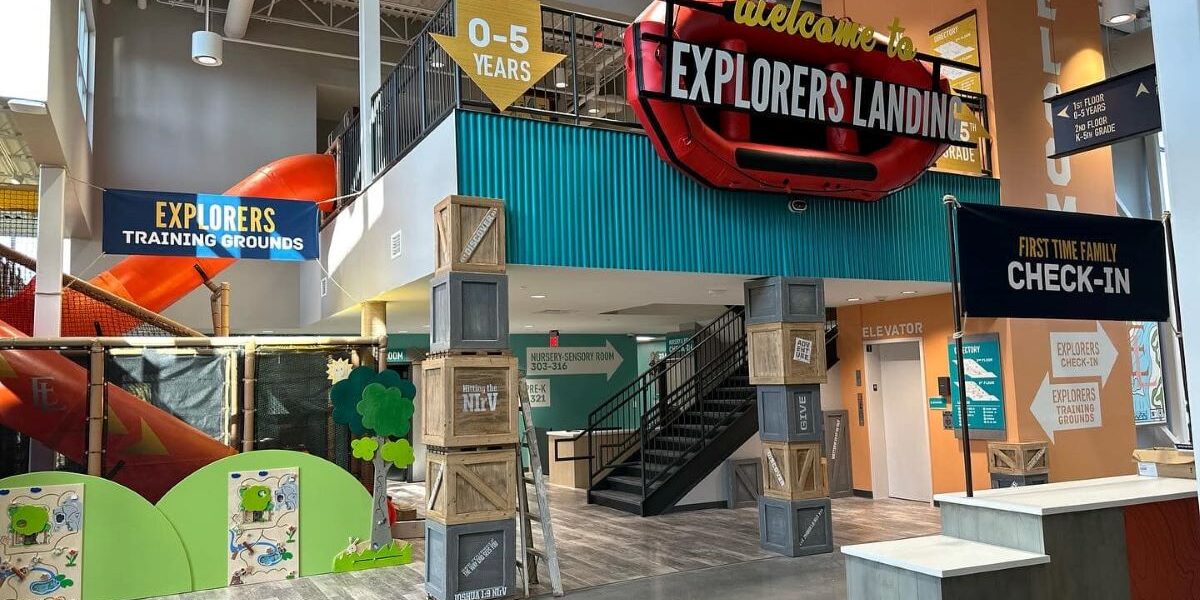The recent announcement of Disney’s staggering $60 billion investment in their theme parks and cruise lines, along with Universal Studios’ massive national and global expansion, underscores the immense value and enduring appeal of themed experiences. This trend isn’t just confined to the entertainment industry; it holds significant relevance for other spaces, including churches.
Instead of opting for neutral or non-themed spatial storytelling for kids, there’s a compelling case for churches to embrace themed environments. These spaces are not only attractive to kids and families but also offer a range of benefits that align with the goals of immersive and engaging community spaces.
Here’s why incorporating themed spatial storytelling in churches, inspired by the success of Disney and Universal, can be a transformative approach.
Immersive Learning
When kids are completely engaged, they learn more effectively, and themed environments excel in capturing their attention. Imagine a Sunday School room transformed into parts of ancient Jerusalem or Noah’s Ark.
This isn’t just about decoration; it’s about creating an environment where biblical stories are no longer just tales told from a book but are vivid, immersive experiences. By walking through a parted Red Sea or sitting in a replica of the Garden of Eden, children can gain a deeper understanding and retention of religious teachings. It’s akin to living the story, not just hearing about it.
Fostering Imagination and Creativity
Themed environments are fantastic catalysts for imagination and creativity. For children, whose daily lives are increasingly hemmed in by screens and structured activities, being able to step into a space where they are encouraged to dream and play roles can be liberating.
This kind of creative play is crucial for cognitive development, including problem-solving and emotional expression. In a church context, such spaces allow children to embody biblical narratives, which not only enhances their understanding but also helps in spiritual development.
Building Community and Belonging
Themed spaces are about more than just aesthetics; they convey a message that children are valued members of the community. When a church invests in creating spaces that are welcoming and specifically designed for children, it sends a powerful signal that they are a crucial part of the congregation.
Such environments can help in nurturing a sense of belonging and identity among kids. In turn, this fosters a stronger, more interconnected community where families feel invested and involved, making the church a hub of shared experiences and support.
Attracting and Retaining Families
In today’s busy world, families have countless options on how to spend their time. Churches face the challenge of not only attracting families but also retaining their engagement. Here, themed environments can serve as a strong incentive. They offer a unique and appealing aspect that can differentiate a church from other community offerings.
For families seeking meaningful and enriching experiences for their children, a church that provides a vibrant, story-rich environment can be particularly attractive. It shows that the church is in tune with the needs and interests of younger generations and is committed to providing a space that supports family time and spiritual education.
Enhanced Emotional Engagement
Themed environments can deeply touch the emotions of those who enter them, which is incredibly powerful in a spiritual setting. When children and families engage in a story-driven space that resonates with their feelings, it can make spiritual teachings more impactful.
For instance, a themed setting that recreates the Nativity scene during Christmas can evoke a profound sense of wonder and joy that enhances the spiritual experience. It’s about connecting with faith on an emotional level, which can be more memorable and moving than traditional methods.
Reinforcement of Messages and Values
In themed spaces, every design choice can serve to reinforce the messages and values a church wants to communicate. This is much like how theme parks use every ride, show, and even landscape to reflect their themes and stories.
For a church, this could mean creating thematic elements that emphasize values like compassion, bravery, or forgiveness. This approach can make abstract values tangible, especially for younger attendees who learn visually and experientially. For example, a boat-themed play area might remind kids of the story of Jesus calming the storm, reinforcing themes of faith and trust amidst fear.
Increased Volunteer Involvement
Themed environments require creativity and maintenance, which opens up new avenues for volunteer engagement. Members of the church community who have skills in art, design, carpentry, or storytelling might find a rewarding outlet in helping to create or maintain these themed spaces.
This not only helps spread the workload but also increases the sense of ownership and community among the congregation. People enjoy contributing to projects that are visible and enjoyed by others, especially when these projects support a good cause like educating and engaging children’s spiritual journeys.
Just like Disney and Universal have captivated millions with their immersive worlds, churches can create spaces that not only tell a story but become a part of the stories of those who visit them. Embracing themed experiences in church settings isn’t just about making spaces fun and engaging for kids—it’s about enriching the way families connect with faith and each other.
By creating immersive, imaginative, and emotionally engaging environments, churches can make spiritual teachings more memorable, foster a deeper sense of community, and ensure their messages resonate with all ages.
If your church is looking to deepen its impact and make a lasting impression on its community, consider taking the first step: form a creative team to brainstorm how themed storytelling can be integrated into your existing spaces. It’s about turning passive learning into an active, vivid journey that everyone in the family can be excited about.
Why not start this Sunday? Gather some ideas, discuss the possibilities, and set the stage for a transformation that could revitalize your church’s approach to ministry.
Justyn Smith serves as a story catalyst at PlainJoe Studios, specializing in aiding churches and non-profit organizations in conveying their distinctive narratives through a blend of strategic, digital, and spatial storytelling approaches, www.plainjoestudios.com.














